Several windowsill herbs can help you naturally manage anxiety through their calming properties. You'll find lavender particularly effective, with its linalool compound reducing stress levels by up to 45%. Chamomile offers gentle sedative effects when steeped as a tea, while lemon balm interacts with your GABA receptors to ease anxious thoughts. Holy basil serves as an adaptogenic herb to lower cortisol levels, and mint provides mild sedative effects through its menthol content. Rosemary can boost mental clarity while reducing anxiety. With proper care and harvesting techniques, these therapeutic herbs can transform your windowsill into a natural anxiety-management garden.
Understanding Herbs for Mental Wellness
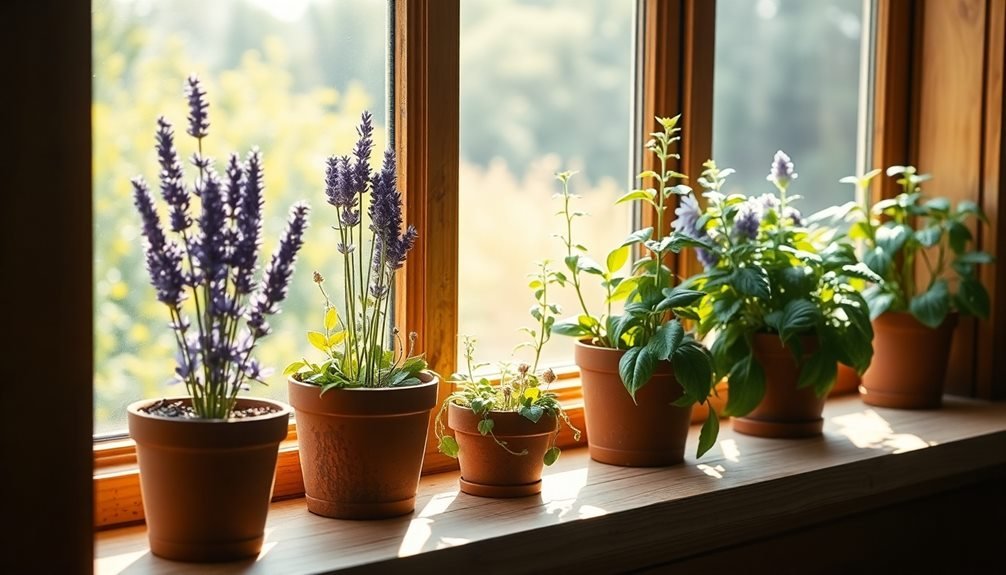
Herbalism offers a natural approach to managing anxiety and promoting mental wellness. When you grow anxiety-reducing herbs on your windowsill, you're tapping into centuries of traditional plant medicine while creating a calming indoor garden space.
Understanding how these herbs work helps you make informed choices about which plants to grow and use. Anxiety-relieving herbs typically work through several mechanisms. Some contain compounds that bind to GABA receptors in your brain, promoting relaxation and reducing stress.
Others influence serotonin levels or contain essential oils that calm your nervous system when inhaled. You'll find that different herbs offer varying levels of sedation, from mild calming effects to stronger relaxation properties.
Before starting your herbal wellness journey, it's vital to research each herb's properties and potential interactions with medications. While herbs are natural, they're still biologically active compounds that deserve respect and careful use.
You should also consider factors like sunlight requirements, watering needs, and growth patterns when choosing which anxiety-reducing herbs to grow. This guarantees your windowsill garden thrives while providing the mental health benefits you're seeking.
Creating Your Windowsill Garden
Setting up your windowsill herb garden starts with selecting containers that have proper drainage holes and fit comfortably on your sill.
You'll need to position your herbs where they'll receive 4-6 hours of direct sunlight daily, typically in a south or west-facing window.
Stock up on well-draining potting soil, small stones for drainage, and basic gardening tools like a spray bottle and pruning scissors to get started.
Choosing Your Planter Setup
Once you've selected your anxiety-relieving herbs, creating the right planter setup becomes crucial for their growth and vigor.
Choose containers that are at least 6 inches deep with adequate drainage holes to prevent root rot. Terra cotta pots work exceptionally well as they allow proper air circulation and moisture control.
You'll need to place a drainage tray beneath each pot to catch excess water and protect your windowsill. Fill your containers with high-quality potting soil specifically designed for herbs, which provides the right balance of nutrients and drainage.
Don't use garden soil, as it's too heavy and may contain pathogens.
Consider using individual pots for each herb species, as they often have different watering needs. If you're short on space, try vertical planters or tiered setups that maximize your windowsill real estate.
Multi-pocket hanging planters can work well, provided they don't block too much light from reaching other plants.
For herbs like lavender and rosemary that prefer drier conditions, add perlite or coarse sand to your potting mix. This guarantees better drainage and prevents waterlogged roots, which can lead to plant stress and reduced therapeutic benefits.
Best Light Requirements
Sunlight plays an essential role in growing healthy, potent anxiety-relieving herbs on your windowsill. Most medicinal herbs need 6-8 hours of direct sunlight daily to develop their therapeutic compounds effectively. South-facing windows provide the most consistent light throughout the day, making them ideal for herbs like lavender, rosemary, and sage.
If you're working with east or west-facing windows, your herbs will receive about 4-6 hours of direct light. These locations work well for mint, lemon balm, and chamomile, which can tolerate partial shade.
North-facing windows typically don't provide enough natural light for most herbs, but you can supplement with grow lights if that's your only option.
Watch for signs that your herbs aren't getting proper light: leggy stems, pale leaves, or slow growth indicate insufficient sunlight. You'll need to either relocate your plants or add artificial lighting.
During winter months, when daylight hours decrease, consider using LED grow lights for 2-4 hours daily to maintain healthy growth. Position these lights 6-12 inches above your plants, and adjust the height as your herbs grow taller.
Essential Growing Materials
A successful windowsill herb garden for anxiety relief requires several key materials to get started. You'll need containers with drainage holes, high-quality potting soil specifically formulated for herbs, and small pebbles or gravel for proper drainage. Choose containers that are at least 6 inches deep to accommodate root growth.
Essential tools include a small watering can with a narrow spout, pruning scissors for harvesting, and plant markers to identify your herbs. You'll also want to invest in organic fertilizer designed for edible plants, as chemical fertilizers can affect the therapeutic properties of anxiety-relieving herbs.
Consider adding a humidity tray filled with pebbles and water, especially if you're growing moisture-loving herbs like holy basil or lemon balm. You might also need plant supports or small stakes for taller herbs like lavender or rosemary. A spray bottle is useful for misting leaves and maintaining humidity levels.
Don't forget to gather basic maintenance supplies: a small trowel for replanting, neem oil for natural pest control, and clean cloth for wiping leaves. Having these materials ready guarantees your anxiety-relieving herbs will thrive in their windowsill environment.
Calming Lavender Benefits
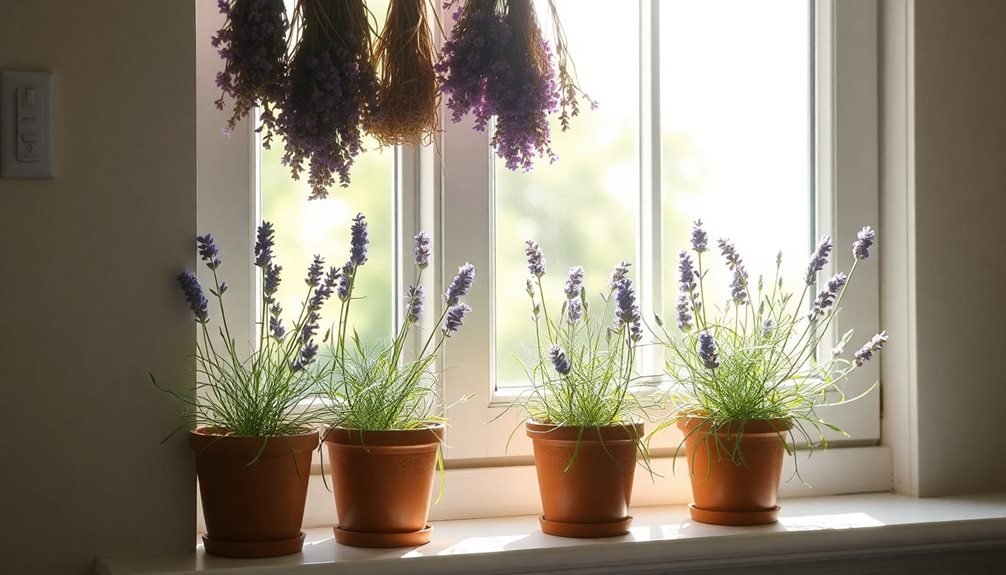
Growing lavender on your windowsill provides powerful anxiety-reducing benefits backed by scientific research. The plant's signature scent contains linalool, a compound proven to lower stress levels and promote relaxation by interacting with your brain's neurotransmitters.
You'll find that simply brushing your fingers against the plant's leaves releases these calming aromatics into your space. Research shows that lavender can reduce anxiety symptoms by up to 45% when used consistently.
You can harvest the flowers to make calming teas, add them to bath sachets, or create aromatherapy bundles for your pillowcase. The plant's essential oils have also demonstrated effectiveness in improving sleep quality and reducing symptoms of mild insomnia.
Beyond its therapeutic properties, lavender acts as a natural air freshener for your home while attracting beneficial pollinators to your windowsill.
You'll benefit most from English lavender (Lavandula angustifolia), as it's compact enough for indoor growing and produces the highest concentration of therapeutic compounds.
Remember to place your lavender in a south-facing window where it'll receive at least six hours of direct sunlight daily for ideal growth and medicinal potency.
Chamomile For Peace
Growing chamomile on your windowsill puts anxiety-reducing herbal tea within arm's reach anytime you need it.
You'll find that this hardy plant thrives in well-draining soil and partial sunlight, making it an ideal indoor companion for stress relief.
When you steep the dried flower heads in hot water, you're creating a gentle sedative tea that's known to calm nerves and promote better sleep.
Growing Calming Chamomile Plants
From beneath your windowsill, chamomile plants can offer both visual beauty and therapeutic benefits in your journey toward tranquility.
You'll find that growing German chamomile (Matricaria recutita) indoors requires minimal effort while providing a steady supply of calming tea throughout the year.
To successfully grow chamomile on your windowsill, you'll need to provide these essential conditions:
- Well-draining potting soil mixed with 30% sand to prevent root rot and guarantee proper moisture levels
- At least 6 hours of direct sunlight daily, preferably from a south-facing window
- Consistent temperatures between 60-68°F (15-20°C) for ideal growth
- Regular watering when the top inch of soil feels dry to the touch
Once your chamomile plants reach 6-8 inches tall, you can start harvesting the flowers.
Pick them when they're fully open but before they begin to droop. You'll know they're ready for harvesting when the white petals are horizontal and the center is domed.
Dry the flowers on a screen in a well-ventilated area, then store them in an airtight container for up to six months.
Health Benefits of Tea
Three remarkable compounds in chamomile tea work together to promote relaxation and ease anxiety. Apigenin, a flavonoid, binds to specific receptors in your brain that reduce anxiety and initiate sleep. Luteolin acts as a natural sedative, helping to calm your nervous system, while bisabolol offers both anti-inflammatory and anti-anxiety properties.
When you brew fresh chamomile tea from your windowsill herbs, you'll get the maximum benefit from these compounds. Steep the flowers for 5-10 minutes in hot water (not boiling) to extract the beneficial properties without destroying them. You'll notice the tea's subtle apple-like aroma, which itself can trigger a relaxation response.
Regular consumption of chamomile tea can help lower cortisol levels, your body's primary stress hormone. You'll find it most effective when drunk 30-45 minutes before bedtime, though it's beneficial any time you're feeling anxious.
For the best results, drink 2-3 cups daily, especially during periods of high stress. The tea's benefits are cumulative, so you'll experience stronger anxiety-reducing effects with consistent use.
Lemon Balm's Soothing Properties
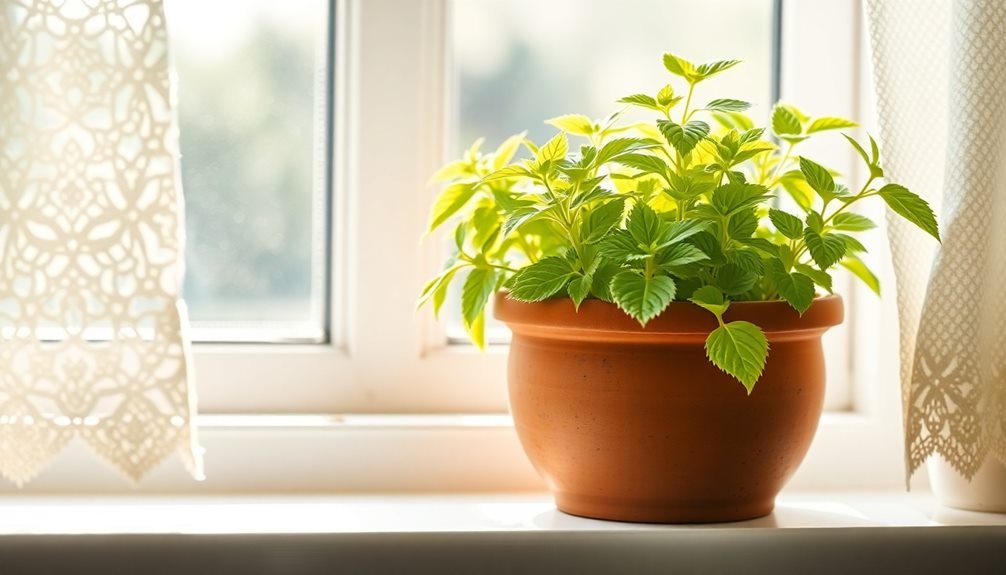
Lemon balm, a gentle member of the mint family, stands out as one of the most effective herbs for calming anxious thoughts. When you grow this fragrant herb on your windowsill, you'll have easy access to its anxiety-reducing properties whenever you need them.
Research has shown that lemon balm contains compounds that interact with GABA receptors in your brain, helping to reduce stress and promote relaxation.
You can harness lemon balm's soothing benefits in several proven ways:
- Steep fresh leaves in hot water for 5-10 minutes to make a calming tea that's perfect before bedtime or during stressful moments.
- Add crushed leaves to your bath water for an aromatherapeutic soak that eases tension and promotes better sleep.
- Create a simple tincture by soaking leaves in alcohol for 4-6 weeks to have a concentrated form ready when anxiety strikes.
- Gently rub a fresh leaf between your fingers and inhale the lemony scent for immediate stress relief.
Your windowsill-grown lemon balm requires minimal care – just regular watering and six hours of daily sunlight.
You'll find it grows quickly, ensuring you'll always have this natural anxiety remedy within reach.
Holy Basil For Stress Relief
With its rich history in Ayurvedic medicine, holy basil (Ocimum sanctum) offers powerful adaptogenic properties that help your body cope with stress. You'll find this aromatic herb can lower your cortisol levels while promoting mental clarity and emotional balance. Growing holy basil on your windowsill guarantees you'll have fresh leaves ready whenever anxiety strikes.
| Benefit | How to Use | Best Time |
|---|---|---|
| Reduces stress | Fresh tea | Morning |
| Improves focus | Tincture | Afternoon |
| Calms nerves | Dried leaves | Evening |
| Boosts mood | Essential oil | As needed |
To grow holy basil successfully, place it in a south-facing window where it'll receive 6-8 hours of sunlight daily. Water it when the top inch of soil feels dry, and pinch off flowering buds to encourage bushier growth. You can harvest leaves throughout the growing season by cutting stems just above a leaf node.
For anxiety relief, steep 1-2 teaspoons of fresh leaves in hot water for 5 minutes. You'll notice holy basil's distinctive clove-like aroma, which signals the presence of beneficial compounds like eugenol and rosmarinic acid that contribute to its stress-relieving effects.
Growing Mint For Anxiety
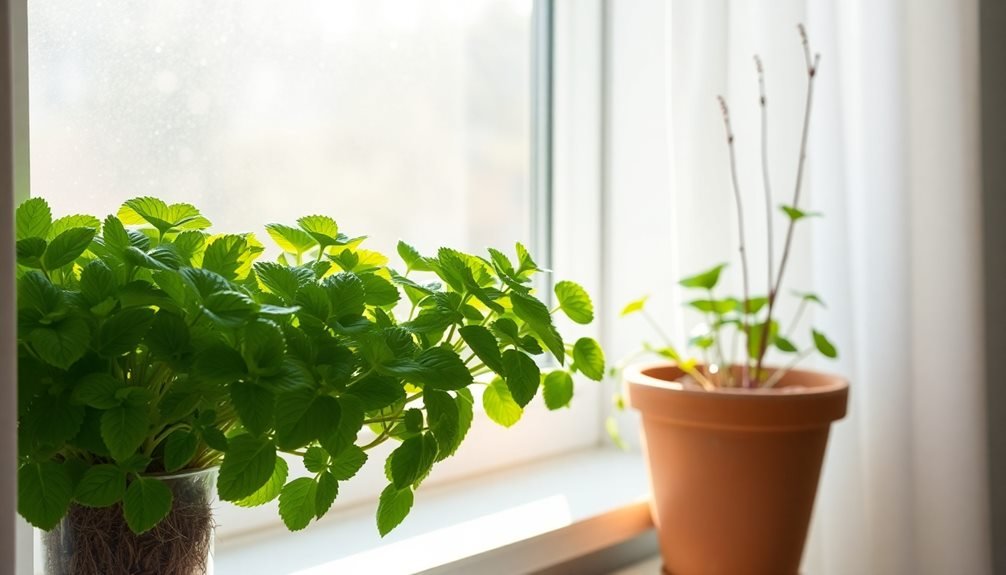
Mint's easy-care nature makes it the perfect anxiety-fighting herb to grow on your windowsill, where it'll thrive in well-draining soil and partial sunlight.
When you're feeling anxious, you can pick fresh mint leaves to brew a calming tea or add them to water, as the herb's natural compounds help reduce stress and promote relaxation.
Regular pruning encourages bushier growth and provides you with a steady supply of leaves, while also preventing the plant from becoming leggy.
Mint Growing Care Tips
Growing fresh mint on your windowsill requires minimal effort while offering maximum anxiety-relieving benefits. Your mint plants will thrive when you provide them with the right growing conditions and consistent care throughout the year.
Mint grows best in well-draining potting soil with adequate moisture retention. Place your mint container in a spot that receives 4-6 hours of indirect sunlight daily, as direct sun can scorch the leaves. Keep the soil consistently moist but not waterlogged, and mist the leaves occasionally to maintain humidity.
Your mint will flourish when you follow these essential care steps:
- Pinch off the growing tips regularly to encourage bushier growth and prevent flowering.
- Fertilize monthly with a balanced, water-soluble plant food during the growing season.
- Prune back leggy stems to maintain a compact shape and prevent the plant from becoming unruly.
- Repot every spring using fresh potting soil, as mint's vigorous root system quickly fills containers.
Remember to harvest leaves frequently for tea or other uses, as regular harvesting promotes healthy growth and guarantees a continuous supply of anxiety-relieving mint.
Health Benefits of Mint
The numerous health benefits of mint make it an excellent choice for managing anxiety naturally. When you consume mint as a tea or use it aromatically, you'll experience its calming effects on your nervous system. Research shows that mint contains compounds that help reduce stress hormones and promote relaxation.
| Benefit | How It Helps |
|---|---|
| Muscle Relaxation | Reduces physical tension and body aches associated with anxiety |
| Mental Clarity | Improves focus and reduces mental fatigue |
| Digestive Comfort | Eases stomach upset often triggered by stress |
| Sleep Support | Promotes better sleep quality when used before bedtime |
You'll find that mint's natural menthol content acts as a mild sedative, helping to quiet racing thoughts and promote a sense of peace. It's particularly effective when you're feeling overwhelmed or experiencing anxiety-induced headaches. The herb's adaptogenic properties help your body better manage stress responses, while its antioxidants support overall brain health. When you incorporate mint into your daily routine, whether through tea, aromatherapy, or adding fresh leaves to water, you're giving your body a natural tool to combat anxiety symptoms.
Harvesting and Using Mint
Along with proper care, harvesting mint at the right time guarantees you'll get the most anxiety-relieving benefits from your plants. For ideal potency, harvest your mint leaves in the morning after the dew has dried but before the day's heat sets in. You'll want to pick young, vibrant leaves before the plant starts flowering, as these contain the highest concentration of essential oils.
Store your freshly harvested mint by either drying the leaves or keeping them fresh. To dry them, bundle 5-10 stems together and hang them upside down in a dark, well-ventilated area. For fresh storage, wrap the stems in damp paper towels and place them in a plastic bag in your refrigerator.
There are several effective ways to use your mint for anxiety relief:
- Steep fresh or dried leaves in hot water for 5-10 minutes to make a calming tea.
- Add crushed leaves to your bath water for a relaxing soak.
- Place dried leaves in a sachet under your pillow to promote restful sleep.
- Rub crushed leaves between your fingers and inhale deeply for immediate stress relief.
Rosemary's Calming Effects
Fragrant rosemary offers more than just culinary benefits – research shows it can considerably reduce anxiety levels and improve mental clarity. When you grow rosemary on your windowsill, you'll have constant access to this powerful herb's calming properties through both aromatherapy and consumption.
| Benefit | How to Use |
|---|---|
| Stress Relief | Rub fresh leaves between fingers and inhale |
| Mental Focus | Add sprigs to hot water for tea |
| Sleep Aid | Place dried sprigs under pillow |
| Mood Boost | Add to bath water |
| Memory Enhancement | Diffuse essential oil |
You'll find rosemary particularly easy to maintain indoors, as it thrives in bright sunlight and doesn't need frequent watering. To harness its anxiety-reducing properties, you can simply brush your hand against the plant's leaves while passing by, releasing its therapeutic oils into the air. For a more concentrated effect, steep fresh rosemary sprigs in hot water for 5-10 minutes to make a calming tea. The herb's active compounds, including rosmarinic acid and carnosic acid, help reduce cortisol levels while improving cognitive function – making it an excellent choice for managing both stress and mental fatigue.
Caring For Your Anxiety Garden
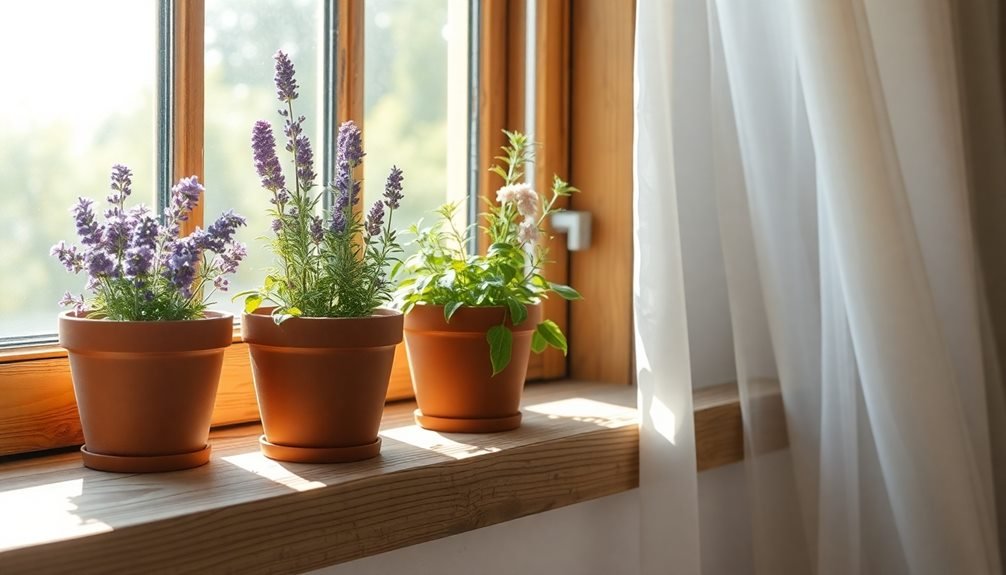
Building on rosemary's success, maintaining your complete anxiety-relief garden requires specific attention to create a thriving indoor sanctuary.
You'll need to monitor your herbs daily and provide them with consistent care to guarantee they produce the calming compounds that help reduce anxiety symptoms.
Your windowsill garden needs these essential care elements:
- Light: Position your herbs where they'll receive 6-8 hours of direct sunlight daily, or supplement with grow lights during darker months.
- Water: Check soil moisture with your finger – water when the top inch feels dry, and guarantee pots have proper drainage to prevent root rot.
- Temperature: Keep herbs between 65-70°F (18-21°C), away from drafty windows and heating vents.
- Pruning: Harvest leaves regularly to encourage bushier growth, but never remove more than 1/3 of the plant at once.
Don't forget to rotate your pots weekly to prevent plants from leaning toward the light.
You'll also need to fertilize monthly with a balanced, water-soluble fertilizer during growing season.
If you notice yellowing leaves or weak growth, adjust your care routine immediately to maintain your herbs' therapeutic properties.
Best Sunlight And Temperature
The ideal growing conditions for anxiety-reducing herbs require careful attention to light exposure and temperature control. Most calming herbs like lavender, chamomile, and lemon balm need at least 6 hours of direct sunlight daily.
You'll want to place them near a south-facing window, where they'll receive the most intense light throughout the day. If you don't have adequate natural light, consider using LED grow lights positioned 6-12 inches above your plants.
Temperature management is equally significant for your anxiety garden's success. Most herbs thrive in temperatures between 65-70°F (18-21°C).
You'll need to keep them away from drafty windows during winter and air conditioning vents in summer. If your windowsill gets too hot, use a sheer curtain to filter intense afternoon sun.
Don't let your herbs touch cold window panes, as this can damage their leaves.
Monitor humidity levels too – most anxiety-reducing herbs prefer 40-50% humidity.
You can maintain proper moisture by placing your pots on a tray filled with pebbles and water, ensuring the pot bottoms don't sit directly in water. This creates a humid microclimate around your plants without risking root rot.
Harvesting Your Mental Wellness Herbs
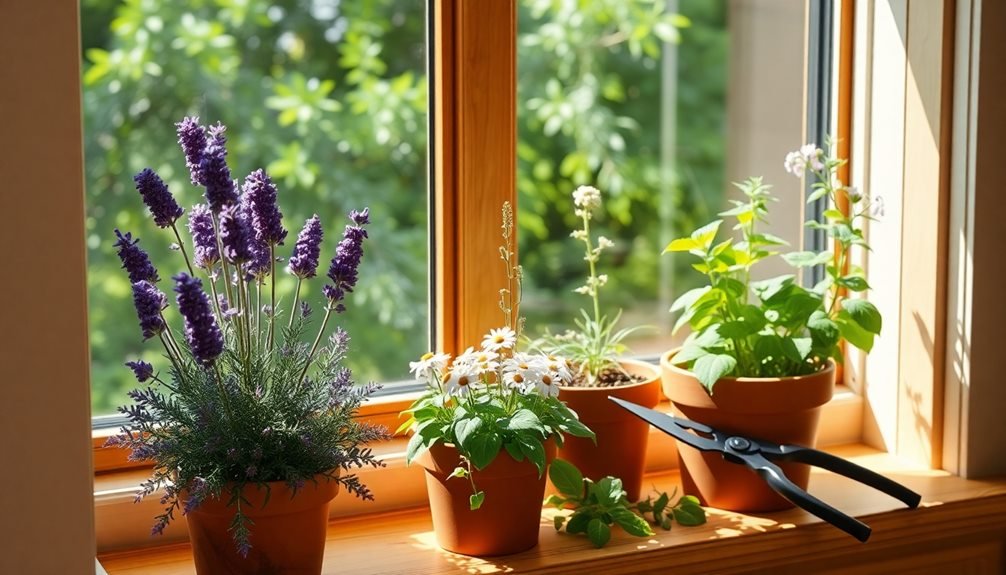
When harvesting anxiety-reducing herbs, proper timing and technique make all the difference in their therapeutic potency. You'll want to collect your herbs in the morning after the dew has dried but before the day's heat sets in. This timing guarantees the highest concentration of essential oils and beneficial compounds.
For most anxiety-reducing herbs like lavender, chamomile, and lemon balm, you'll get the best results by harvesting just before they flower. Cut stems about 6 inches from the base, leaving enough foliage for the plant to regenerate. Don't harvest more than one-third of the plant at once to maintain its health.
Here's how to properly harvest your mental wellness herbs:
- Use clean, sharp scissors or pruning shears to prevent plant damage and disease transmission.
- Cut stems at a 45-degree angle to promote healthy regrowth and prevent water pooling.
- Remove any damaged, diseased, or yellowed leaves before drying.
- Gather herbs into small bundles, securing them with twine or rubber bands.
After harvesting, gently shake the stems to remove any insects, but don't wash them unless they're visibly dirty, as moisture can reduce their therapeutic properties.
Frequently Asked Questions
Can Anxiety Herbs Interact Negatively With Prescription Medications?
Yes, you'll need to be careful as anxiety herbs can interact with medications. It's essential that you talk with your doctor before using any herbal remedies alongside your prescriptions to avoid dangerous interactions.
How Long Does It Take for Windowsill Herbs to Show Anxiety-Reducing Effects?
You'll notice anxiety-reducing effects from fresh windowsill herbs within 15-30 minutes when consumed as tea. Regular daily use over 2-3 weeks helps build up their calming benefits for longer-lasting results.
Are These Herbs Safe for Pregnant Women Experiencing Anxiety?
You'll need to consult your doctor before using any herbs during pregnancy. While some herbs like chamomile are generally safe, others can be harmful. Don't self-medicate – get professional guidance first.
Which Anxiety-Reducing Herbs Are Toxic to Pets?
You'll need to keep lavender, chamomile, and valerian away from your pets as they're toxic. Don't let cats near catnip if you're using it for anxiety – it can overstimulate them.
Can Windowsill Herbs Lose Their Anxiety-Relieving Properties if Not Harvested Regularly?
You'll need to harvest your anxiety-relieving herbs regularly to maintain potency. If you don't clip them, they'll flower and lose strength. Regular pruning keeps the plants producing fresh, therapeutic leaves.
In Summary
Growing anxiety-reducing herbs on your windowsill lets you take control of your mental wellness naturally. You'll find peace in tending to lavender, chamomile, lemon balm, and rosemary while enjoying their calming benefits through teas and aromatherapy. Remember to harvest your herbs regularly, keeping them in a sunny spot with good airflow. With proper care, you'll always have fresh, natural remedies at hand for stressful moments.





Leave a Reply